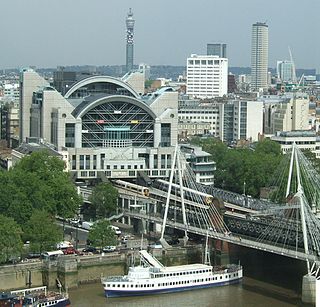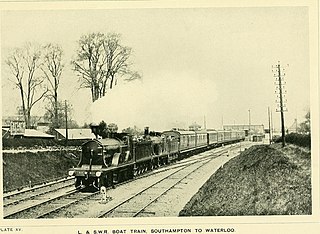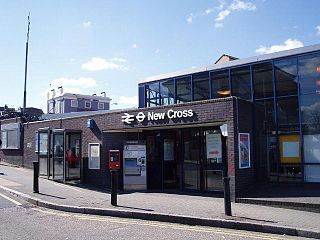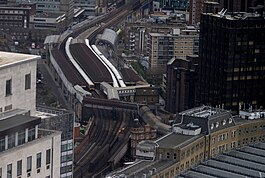
Waterloo station, also known as London Waterloo, is a central London terminus on the National Rail network in the United Kingdom, in the Waterloo area of the London Borough of Lambeth. It is connected to a London Underground station of the same name and is adjacent to Waterloo East station on the South Eastern Main Line. The station is the terminus of the South West Main Line to Weymouth via Southampton, the West of England main line to Exeter via Salisbury, the Portsmouth Direct line to Portsmouth Harbour which connects with ferry services to the Isle of Wight, and several commuter services around west and south-west London, Surrey, Hampshire and Berkshire.

London Bridge is a central London railway terminus and connected London Underground station in Southwark, south-east London. It occupies a large area on three levels immediately south-east of London Bridge, from which it takes its name. The main line station is the oldest railway station in London fare zone 1 and one of the oldest in the world having opened in 1836. It is one of two main line termini in London to the south of the River Thames and is the fourth-busiest station in London, handling over 50 million passengers a year.

Cannon Street station, also known as London Cannon Street, is a central London railway terminus and connected London Underground station in Travelcard zone 1 located on Cannon Street in the City of London and managed by Network Rail. It is one of two London termini of the South Eastern Main Line, the other being Charing Cross, while the Underground station is on the Circle and District lines, between Monument and Mansion House. The station runs services by Southeastern, mostly catering for commuters in southeast London and Kent, with occasional services further into the latter.

Charing Cross railway station is a central London railway terminus between the Strand and Hungerford Bridge in the City of Westminster. It is the terminus of the Southeastern Main Lines to Dover via Ashford and Hastings via Tunbridge Wells. All trains are operated by Southeastern, which provides the majority of commuter and regional services to south-east London and Kent. It is connected to Charing Cross Underground station and is near to Embankment Underground station and Embankment Pier.

The London and South Western Railway was a railway company in England from 1838 to 1922. Originating as the London and Southampton Railway, its network extended to Dorchester and Weymouth, to Salisbury, Exeter and Plymouth, and to Padstow, Ilfracombe and Bude. It developed a network of routes in Hampshire, Surrey and Berkshire, including Portsmouth and Reading.

Vauxhall is a National Rail, London Underground and London Buses interchange station in central London. It is at the Vauxhall Cross road junction opposite the southern approach to Vauxhall Bridge over the River Thames in the district of Vauxhall. The mainline station is run by the South Western Railway and is the first stop on the South West Main Line from London Waterloo towards Clapham Junction and the south-west. The Underground station is on the Victoria line and the station is close to St George Wharf Pier for river services.

New Cross railway station serves New Cross in south-east London, England. It is 4 miles 68 chains (7.8 km) down the line from London Charing Cross and is in London fare zone 2. The platforms are lettered rather than numbered to avoid confusion with those at New Cross Gate by staff who worked at both stations before privatisation of the stations in 1997. Platform D is used exclusively by London Overground services. Ticket barriers control access to all platforms.

Epsom railway station serves the town of Epsom in Surrey, England. It is located off Waterloo Road and is less than two minutes' walk from the town's high street. It is 14 miles 18 chains (22.9 km) down the line from London Waterloo.

Catford Bridge railway station is on the Mid-Kent Line, serving Hayes line trains from London to Hayes. It lies between Ladywell and Lower Sydenham stations, 7 miles 42 chains (12.1 km) from London Charing Cross and in Travelcard Zone 3. It is adjacent to Catford railway station on the Catford Loop line. The station entrance is on Catford Road, a part of the South Circular Road (A205), and has brick buildings on both platforms, though the up side building is no longer in use by the railway. The station is managed by Southeastern, who operate all trains serving it.

St Johns railway station is in the London Borough of Lewisham. It lies 5 miles 47 chains (9.0 km) down the South Eastern Main Line from London Charing Cross, and is situated between New Cross and Lewisham.

Ladywell railway station is in Ladywell, in the London Borough of Lewisham in south east London, in Travelcard Zone 3. It is 6 miles 62 chains (10.9 km) measured from London Charing Cross.

Lower Sydenham railway station is located on the boundary of the London Borough of Bromley and the London Borough of Lewisham in south-east London. It is 9 miles 2 chains (14.5 km) measured from London Charing Cross.

New Beckenham railway station serves Beckenham in the London Borough of Bromley in south-east London, in Travelcard Zone 4. It is 9 miles 44 chains (15.4 km) measured from London Charing Cross.

Hither Green is a railway station located in Hither Green in the London Borough of Lewisham, south-east London. It is 7 miles 16 chains (11.6 km) down the line from London Charing Cross and is situated between Lewisham and either Grove Park or Lee depending on the route.

Guildford railway station is at one of three main railway junctions on the Portsmouth Direct Line and serves the town of Guildford in Surrey, England. It is 30 miles 27 chains down the line from London Waterloo via Woking.

Rainham railway station is on the Chatham Main Line in South East England, serving the town of Rainham, Kent. It is 38 miles 74 chains (62.6 km) down the line from London Victoria and is situated between Gillingham and Newington.

Sevenoaks railway station is a railway station on the South Eastern Main Line in England, serving the town of Sevenoaks, Kent. It is 22 miles 9 chains (35.6 km) down the line from London Charing Cross and is situated between Dunton Green and Hildenborough stations. Trains calling at the station are operated by Southeastern and Thameslink.

Folkestone West railway station is on the South Eastern Main Line in England, serving the western area of Folkestone, Kent. It is 69 miles 22 chains (111.5 km) down the line from London Charing Cross. All trains that call are operated by Southeastern.

Robertsbridge railway station is on the Hastings line in the south of England and serves the village of Robertsbridge, East Sussex. It is 49 miles 47 chains (79.8 km) down the line from London Charing Cross. The station and all trains serving it are operated by Southeastern.

Staines railway station is on the Waterloo to Reading line and is the junction station for the diverging Windsor line, in southern England to the west of London. It is 19 miles 2 chains (30.6 km) down the line from London Waterloo.


























